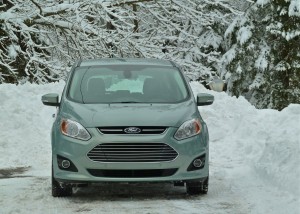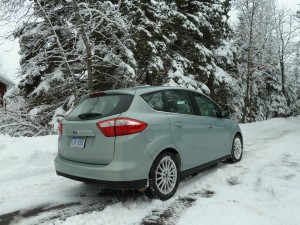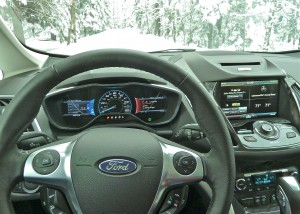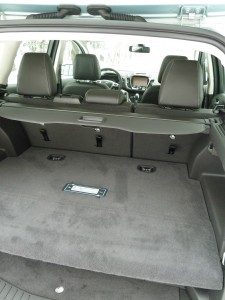C-Max style, room, economy defy convention
Rarely has a new vehicle been introduced with more confusion and criticism than celebration.
Hmmm…confusion, criticism, and celebration. Maybe that’s how they came up with the name “C-Max.” Every automaker likes to boast about uniqueness, and how their new product defies categorization, but Ford seems to have mastered the trick with the new C-Max.
It seems to be neither fish nor fowl, car or truck, small minivan or spacious mini car. It comes as a hybrid, or a plug-in hybrid, known as Energi. And it has remarkable interior space for being so compact and small on the outside.
Amid a flurry of quirky or trendy names that feature letters, numbers, or retrospective monickers, Ford has confused U.S. consumers and critics with the new C-Max. When it was first announced, many thought it was a large semi-trailer-hauling truck, and even though it has been available in Europe with conventional engines, when the car magazines and North American Car and Truck of the Year executives made their choices on categorizing, it wound up listed among trucks, and even minivans.
In reality, the C-Max is a cleverly designed and executed small capsule of a car, shaped indeed like a minivan or tiny crossover SUV. It finished third among North American Truck/Utility of the Year candidates, behind the Ram 1500 and the Mazda CX-5, and Motor Trend listed it in its truck preview issue right there with the Tahoes and Rams and Ford cousins like the F150 and Explorers. Ford itself continually draws comparisons to various Toyota Prius models.
Introduced right before the end of the 2012 calendar year, the C-Max appeared to be a blunt instrument in the vast array of small economy vehicles. Rounded off, its capsule shape bears a strong resemblance to the new Escape SUV, or the Focus or Fiesta compact and subcompact, aimed at aerodynamic smoothness.
Prices range from $25,000 to over $30,000 for the fully-equipped plug-in Energi model, but the C-Max performance is what will make it a large-volume seller. You quickly forget how small it is outside when you climb in and find the tall roof providing lots of headroom, adequate rear seat room and spacious cargo area inside the rear hatch, with, of course, expansion via fold-down rear seats. And you can forget it’s a hybrid by how swiftly it accelerates or willingly passes other cars when you drive it even a little aggressively.
One report in an auto magazine stressed that the driver didn’t get great mileage with the accompanying excuse that the staff of drivers always drive for performance, and lead-footing it impeded the C-Max’s mileage. Well, it’s fun to drive high-performance cars with a dose of heavy acceleration, but it makes no sense to road-test a hybrid for optimum fuel economy and drive it for acceleration with your foot on the floor. The C-Max, however, can make you forget it’s a hybrid and drive it normally.
Hybrid vehicles have an electric battery pack charged up by a generator, and an electric motor that provides the force to move the vehicle. Unlike pure electric cars, hybrids have an integrated gasoline engine, which can help move the car (in most cases) and can recharge the battery pack while also powering the wheels. Toyota is an exception, because its gas engine only runs a generator to make electric power for running the car, and its gas engine alone won’t move the car.
Ford has been laps ahead of its domestic rivals in creation and development of hybrid power, doing its own thing on the Escape more than a decade ago. In more recent years, the Fusion has made impressive use of hybrid power as well. For the new generation of energy-conscious customers, Ford is now applying its hybrid technology to smaller cars, such as the Focus and Fiesta.
And for now, the C-Max is the focal point. I’ve driven both the C-Max with the hybrid, and the C-Max Energi, with the plug-in hybrid. The C-Max comes only with those power-trains, although European C-Maxes are available with conventional gas or diesel engines. For fuel economy, the more hybrids can run on electric power, the less gasoline is required, hence some pretty lofty fuel economy figures. So you ease it down to a stop, for maximum regenerative energy from braking for your battery pack, and you ease it away from start-up — nothing abrupt or severe — to stay on the electric power as much as possible.
While the regular C-Max hybrid engine works efficiently, to power the car and/or charge the battery pack, it would take considerable driving to fully charge the battery pack. The plug-in version allows for overnight or short-term plugging into an electric outlet to fully charge the battery pack, which allows the C-Max to run moderately for up to 20 miles on electricity alone.
EPA mileage estimate figures for the C-Max are 47 miles per gallon in city driving, while the C-Max Energi shows an astounding 95 mpg in combined driving.
The two cars afforded us some unusual observations. First, I had happened to live with the normal C-Max for a week, and during that time, Consumer Reports came out with a boldly assertive review that practically called the C-Max a fraud. The report said that nobody could approach that EPA 47 mpg estimate in the C-Max in real-world driving. I was just about to drive downtown to a radio studio at about dawn, so I zeroed all the computer calculations on the test C-Max, for my own brief comparison test. I drove down the hill from our rural home on the North Shore of Lake Superior, to Interstate 35. I drove a few miles at 65 miles per hour into Duluth, then another five miles at the prescribed 30 mph. Back on a short stretch of freeway the limit was 50 mph, before exiting downtown and driving up the hill a couple of blocks to find a parking place.
Only then did I click the computer over to calculate my specific 11.5-mile trip. It showed 49.3 miles per gallon. Now, I’m not saying I could get that every day, and I’m not suggesting anyone should expect that, but I drove the speed limit, with no “hyper-miling,” and it was in quite cold temperature with all conditions available. My finding refutes the assertion that nobody could approach 47 mpg in real-world driving, because I got 49.3 in my real-world.
More recently, I had the opportunity to drive the C-Max Energi, but it was a hectic week, with lengthy drives between Duluth and Saint Paul and Minneapolis for the Minnesota high school hockey tournament, and there was no real time to find or plug in the plug-in receptacle for recharging. That left the C-Max to its own devices, which revert to “normal” hybrid duty. There is a long-standing tradition of a “state tournament blizzard” regardless of what kind of winter we’ve had, and we got one.
I wasn’t able to approach the 95 mpg on that particular week, but I was able to record 42 mpg overall including one way from Saint Paul to Duluth, and 34.5 mpg for combined driving through a snowstorm that accompanied our week. And no matter how hard we drove, the worst segment the C-Max recorded was 31.5 mpg. Obviously, it would have been better in warmer weather, on smoother roads, with more city driving, and if I had plugged the little critter in.
We did have one unusual occasion. While attending the Minnesota high school hockey tournament, we had two vehicles. My wife, Joan, and older son, Jack, drove the C-Max a few blocks away and parked it on a side street. They got out, and found the key-fob electric lock to be a bit balky. Thinking nothing more of it, they walked to the games and left the car for several hours. When they returned to get it, nothing worked. The key fob would not unlock the C-Max, and only by taking apart the key and using the manual key in the lock could they get inside. Once there, the push-button start wouldn’t work, and everything was dead in the 15-degree chill.
We left the C-Max there, since it was after midnight, and early the next morning I called Ford Roadside Assistance and they recommended flat-bedding the C-Max to the closest dealership. Very swiftly, the assistance lady told me where it was, and told me that the fellow with the tow truck would be there in 45 minutes. Ten minutes later, he called my cell phone and was already there.
I told him what happened, and that I suspected one of the features of the hybrid had bitten us. When you stop at a red light in a hybrid, you step on the brake and the engine cuts out. It is a significant fuel-saving technique. The same thing happens when you park. My thought was that when it was parked, stepping on the brake caused the engine to cut out, and putting it park and getting out seemed to leave the car in good shape. But it was still activated. And in its activation, the battery became thoroughly drained. Just a theory, but I thought a brief jump start might solve everything.
The tow-truck driver agreed with my theory, and said he drives a Prius, so he knows all the intricacies of hybrids. A very few minutes later, he hooked up the charger and the C-Max jumped to life, and ran very well the rest of the week.
Returning from the Twin Cities to Duluth, I found a light drizzle at 38 degrees changing to a little freezing drizzle at 32 degrees after about 100 miles, and then a bit of accumulating snow at 28 degrees by the time I got closer to Duluth, at about 1 a.m. The C-Max handled well in all cases, including when I headed out the North Shore beyond Duluth and turned up my rural road. As I drove up the two miles, the snow was deeper as I went and was at least a foot deep as I crested the steepest part of the hill.
When I realized a snowplow had left a ridge across my driveway, I had no choice. I turned in and gunned it. The C-Max hurtled through the pile and I made it into my driveway and swerved to a stop up near my garage. As I trudged toward the house, I noticed a flat plateau between the tire tracks, all the way in from the road. The snow was deep enough that the C-Max’s underside had plowed off the top of the snow on the way in.

Cute style, peppy performance, utility all are secondary to ability of C-Max to handle foul weather.
As an avid surveyor of tires on all the cars I test-drive in Minnesota winters, I noted that the C-Max came with Michelin X Green tires, built for low rolling resistance and optimum gas mileage. They just happened to also work on icy roads and through deep snow. Of course, having front-wheel drive, with the main weight over the drive-wheels, helped a lot, too, but in concert, everything worked. I just made sure I put it in park, and firmly pushed the off button until a pleasant little note came up: “Thank you for driving a hybrid.”
Comments
2 Comments on C-Max style, room, economy defy convention
-
Essential Oils on
Thu, 9th Apr 2015 9:02 pm
-
lotus on
Sat, 27th Feb 2016 2:38 pm
Excellent post! We are linking to this great article on our website.
Keep up the good writing.
You are so awesome! I don’t think I’ve read anything like that before. So nice to discover somebody with a few
original thoughts on this subject matter. Seriously.. thanks
for starting this up. This site is one thing that is required
on the web, someone with some originality!
(Thanks. Is your note original…or is it Memorex? — JG)
Tell me what you're thinking...
and oh, if you want a pic to show with your comment, go get a gravatar!






 John Gilbert is a lifetime Minnesotan and career journalist, specializing in cars and sports during and since spending 30 years at the Minneapolis Tribune, now the Star Tribune. More recently, he has continued translating the high-tech world of autos and sharing his passionate insights as a freelance writer/photographer/broadcaster. A member of the prestigious North American Car and Truck of the Year jury since 1993. John can be heard Monday-Friday from 9-11am on 610 KDAL(www.kdal610.com) on the "John Gilbert Show," and writes a column in the Duluth Reader.
John Gilbert is a lifetime Minnesotan and career journalist, specializing in cars and sports during and since spending 30 years at the Minneapolis Tribune, now the Star Tribune. More recently, he has continued translating the high-tech world of autos and sharing his passionate insights as a freelance writer/photographer/broadcaster. A member of the prestigious North American Car and Truck of the Year jury since 1993. John can be heard Monday-Friday from 9-11am on 610 KDAL(www.kdal610.com) on the "John Gilbert Show," and writes a column in the Duluth Reader.